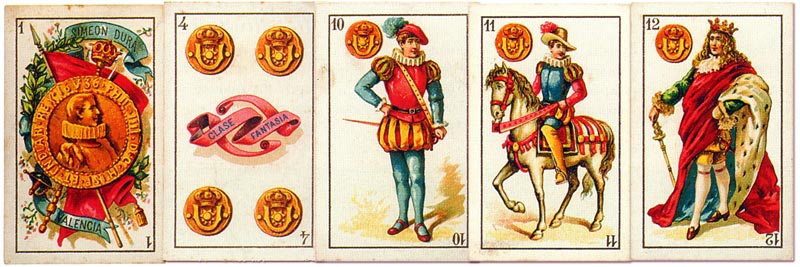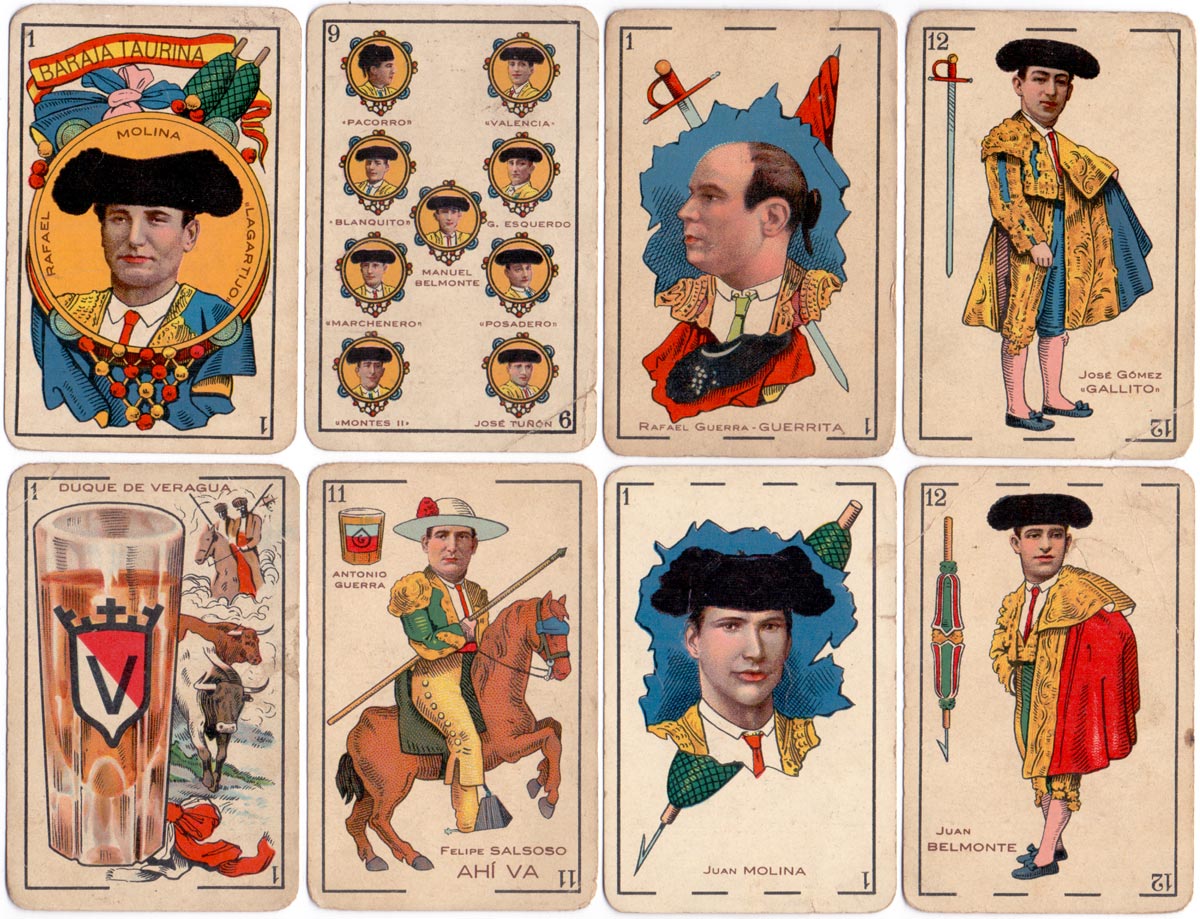Simeon Durá 1871-1940
Simeon Durá of Valencia was one of Spain's most distinguished playing card manufacturers, flourishing between 1871-c.1940.

Simeon Durá of Valencia was one of Spain's most distinguished playing card manufacturers, flourishing between 1871-c.1940. In the same league as Naipes Comas (Barcelona) and Heraclio Fournier (Vitoria), it is believed that Simeon Durá learnt his trade whilst serving as an apprentice with Manáut Hermanos, another playing-card manufacturer located in Valencia. When Manáut Hermanos ceased trading in 1871, Simeon Durá opened his first playing card factory just around the corner, in calle San Vicente 116. Soon afterwards his address changed to Guillem de Castro 130, Valencia. By around 1890 Durá had completed an extensive new factory in Arrancapinos No.29 (renamed Angel Guimerá in c.1930).
Durá's early production followed the same designs which had been used by his predecessors Manáut Hermanos but soon afterwards he commissioned artist E. Pastor to create a range of new, distinctive designs. At the same time Durá acquired modern lithographic printing equipment enabling him to compete effectively with other leading players in the market, and to produce his impressive range of highly artistic designs in high quality.

Above: Simeon Durá's 'El Cid' fantasy Spanish-suited playing cards, designed by E. Pastor, c.1875. These were the first in a series of outstanding designs which Simeon Durá developed over the years to replace those of Manáut Hermanos and to raise his status amongst the public. (Click image to see more).

Above: Simeon Durá's illuminated playing cards for Chocolates 'El Barco' designed by E. Pastor, c.1890. (Click image to see more).

Above: naipes de "Don Quijote" by E. Pastor, printed by Litografía S. Martínez, c.1930. A facsimile edition was published by Heraclio Fournier in 1981 here►
Simeon Durá is known to have exported playing cards to Latin American countries including Argentina, Chile, Cuba, Ecuador, Peru, Puerto Rico and Uruguay, as well as The Philippines. The range of playing cards included fantasy designs as well as standard Spanish National, Catalan and Cadiz-style cards for these markets, including specially printed editions for The Estanco de Naipes del Perú, M. Dominguez y Cía of Valparaiso (Chile) and other overseas customers. Durá also produced Anglo-American style 'poker' playing cards with a very elaborate ace of spades and the brand name 'Fortuna', in various qualities, as well as children's packs, advertising packs, Bézique sets, French Baccarat packs and a special 74-card set of 'roulette' cards.
The imposition in 1904 of tax on playing cards by the Spanish government was a severe setback for playing-card manufacturers, and prices almost doubled as a result. This situation encouraged Simeon Durá to diversify and to undertake various other general printing jobs including posters, picture cards, relief prints and boxes. The bullfighting pack (shown below) was produced during this era.

Above: Simeon Durá's 'Baraja Taurina' was in print from 1916 until the 1930s. It was printed with either square or rounded corners and with various backs, including advertisements for Chocolates Angelical, Barcelona, featuring bullfighter photos on the reverse more →
In c.1931 the company name changed to Hijos de Simeon Durá. However, the Spanish civil war adversely affected the company's fortunes from which it never fully recovered and playing-card production was finally abandoned in the early 1950s. The company continued as a general printer until 1970.

By Simon Wintle
Member since February 01, 1996
I am the founder of The World of Playing Cards (est. 1996), a website dedicated to the history, artistry and cultural significance of playing cards and tarot. Over the years I have researched various areas of the subject, acquired and traded collections and contributed as a committee member of the IPCS and graphics editor of The Playing-Card journal. Having lived in Chile, England, Wales, and now Spain, these experiences have shaped my work and passion for playing cards. Amongst my achievements is producing a limited-edition replica of a 17th-century English pack using woodblocks and stencils—a labour of love. Today, the World of Playing Cards is a global collaborative project, with my son Adam serving as the technical driving force behind its development. His innovative efforts have helped shape the site into the thriving hub it is today. You are warmly invited to become a contributor and share your enthusiasm.
Related Articles

Pierre Varangot
Tracing the origins, legality and legacy of Pierre Varangot’s San Sebastián deck.

Archaic Spanish-suited pattern from Bayonne
Archaic Franco-Spanish pattern from Bayonne by a manufacturer with the initals M.V.

Tarot de las Coscojas
Historical playing card design, tarot symbolism and an almost psychedelic medieval surrealism.

Tarot de Valverde de la Vera
A series of 24 surrealist engravings by Mexican artist Claudio Favier in which archetypal Tarot alle...

Baraja de Juan Martín Zamorano
Deck inspired by El Pendón de los Zamorano, a military pennant dating from 1501, published by Priego...

Heráldica Castanyer No. 16
Strange variant of international pattern cards for poker or bridge.

Fantasy Spanish-suited deck
Fantasy Spanish-suited deck by Bertschinger y Codina, Barcelona.

Bertschinger y Codina - Cartes Françaises
French ‘Paris’ pattern made by Bertschinger y Codina, Barcelona, c.1850.

Braulio Fournier
Baraja Nº 1 produced by Braulio Fournier, Burgos, c.1868.

Pirritx eta Porrotx
Happy Families card game from the Spanish Basque Country.

Naipe Vizcaino
‘Naipe Vizcaino’ designed by Javier Urkiri and published by Industrias Gráficas Castuera and the Caj...

Baraja Turística del País Vasco
Basque poker deck of 55 cards published by Fournier with scenic views of the Basque Country.

Baraja Vasca
Spanish Basque Country deck with original drawings by María Isabel Ibañez de Sendadiano.

Baraja Cultura Española
ASESCOIN pack for 2022 designed by M.A. Corella featuring famous Spaniards and notable buildings.

Laurenzo Propagine
Spanish-suited cards made in Italy by Laurenzo Propagine.

Jeu de 7 familles Les Dynasties d’Artisans Basques
Long-standing Basque businesses represented in a traditional card game with illustrations by Odile A...
Most Popular
Our top articles from the past 28 days

